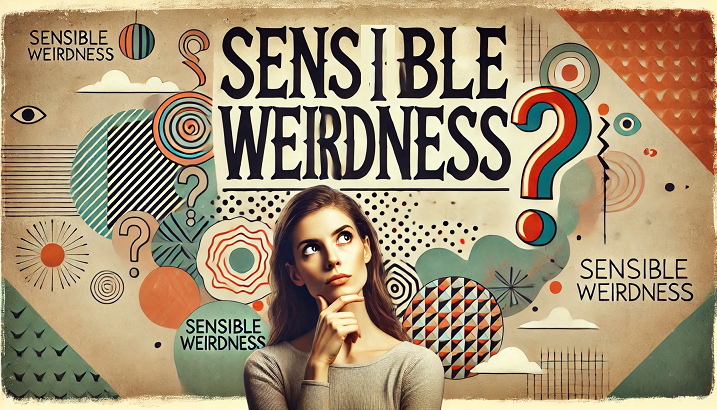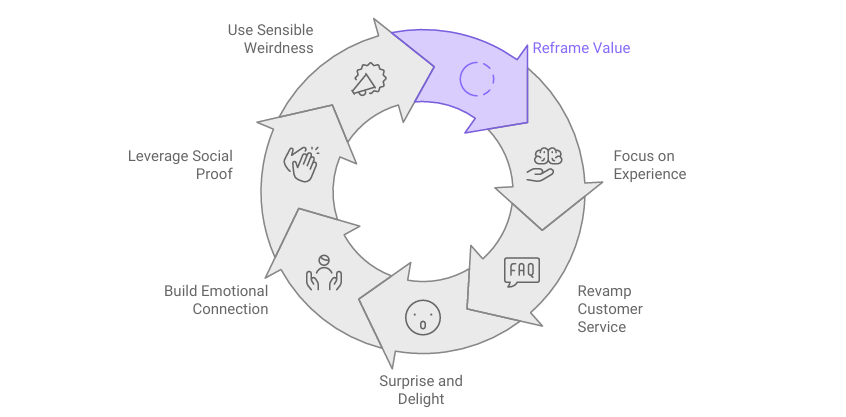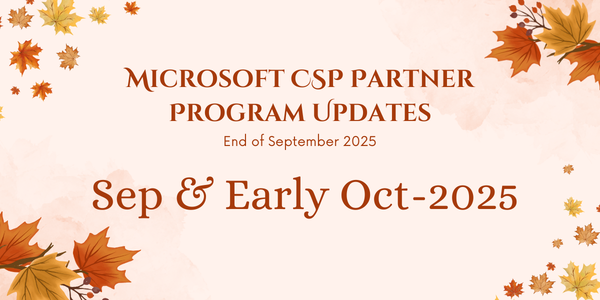Reframing Value and the Power of Psychology in Business: Irrational ways to Boosting CSP Growth

As a CSP Partner and entrepreneur, it's easy to get caught up in constantly trying to innovate on new products and managed services.
I am as guilty as many in similar shoes, for most of the customer growth or value questions, we turn to improving or adding something technical / logical, a roadmap to make the product 10 times better than competitors, with better futures and integrations etc.
But Rory Sutherland’s marketing psychology teaches us something crucial: logic doesn't always drive customer decisions. Perception is often more potent than reality.
In one of the videos I watched recently, he explains something that goes likes this (at least I registered it this way):
you can’t make below average food and create a top-class restaurant just with presentation, but once you make a table staple food, it comes down to the perception of the value and not the actual value of the item, it’s about how you present the product or service and the story you associate with it, the psychology, not the logic that is going to matter
In today's competitive landscape, demonstrating value to customers is crucial for Microsoft Cloud Solution Provider (CSP) partners. With the rise of cloud adoption, customers have numerous options to choose from, making it essential for Microsoft CSP partners to differentiate themselves.
Rory Sutherland, the Ogilvy UK Vice Chairman and author of Alchemy, has spent his career dissecting the space between psychology, marketing, and behavioral economics. He argues that humans are not always rational and our emotional responses significantly influence what we buy and why. His marketing psychology contends that instead of solely focusing on objective value propositions, businesses should tap into the often-irrational ways humans perceive value.
Key Ideas:
Perception shapes reality: Our experience of cost, value, and even pain is not solely determined by objective factors but significantly influenced by our perceptions. (See the electric shock experiment with dogs).
Reframing transforms value: Identical actions can be perceived positively or negatively depending on how they are framed. (See the examples of paying taxes vs. donating to a hospital, the Greek bailout, and the use of dot matrix displays in the London Underground).
Psychological solutions can be more effective and cheaper than technical ones: Sometimes addressing a problem through psychological means can yield better results than costly technological solutions. (See the examples of the Eurostar and the antibiotic pill regimen).
Marketing creates legitimate value: By shaping perceptions, marketing adds value just as tangible product features do. Von Mises uses the analogy of the shepherd and the hat maker to illustrate this point.
Distinctiveness and memorability matter: Successful products often have memorable quirks or features that make them stand out. (See the examples of Rolls Royce, Veuve Clicquot, and DoubleTree cookies).
Brands build trust: Strong brands act as a shortcut for trust, reducing the perceived risk in making a purchase or decision. (See the analogy of encountering a celebrity on the street).
Fame changes the rules: Achieving fame significantly alters how a company is perceived and operates, attracting customers and talent, generating trust, and affording greater leeway in case of mistakes.
Embrace "psycho-logic": Humans have evolved to make decisions under conditions of uncertainty, often relying on heuristics like habit and social copying. Businesses should consider these tendencies when designing products and experiences.
Don't over-optimize: While some degree of optimization is beneficial, taking it too far can backfire. (See the example of making an electric razor too quiet).
Consider the "user imagery": The image a product evokes in the minds of consumers can be as important as its actual features. (See the examples of early electric cars, Google Glass, and Tesla).
Prioritize clarity and consistency in branding: Focus on establishing a clear brand promise and maintaining consistency in your messaging and visuals.
The importance of storytelling: We tend to post-rationalize our decisions, creating a narrative that makes them seem logical in hindsight. This highlights the power of storytelling in shaping perceptions.
Reframing Value: The Heart of Rory Sutherland Marketing Psychology
One of Sutherland’s key principles, "reframing," illustrates how presentation dramatically alters perceived value. He uses the example of the Eurostar train line between London and Paris.
Rather than solely focusing on reducing travel time, what if the company focused on improving the experience during the journey? Imagine improved onboard WiFi, a compelling food and beverage selection, or even in-transit entertainment options. By reframing the journey as an experience, customers may find greater value, even if the trip isn't faster.
Uncommon Sense in Action: Examples of Rory Sutherland Marketing Psychology
Throughout his work, Sutherland highlights businesses that have successfully employed the principles of behavioral economics. Let's explore some noteworthy case studies:
1. Red Bull
Red Bull achieved massive success by positioning its expensive, small-canned energy drink as exclusive and aspirational. This marketing tactic created an aura of mystique and coolness around the brand, justifying its premium price point. This strategy is a prime example of "perceived value" at play, a concept deeply rooted in his teachings.
2. Google
Think about Google's simple search bar. It revolutionized how we access information by making search easy and intuitive, making Google indispensable. Sutherland’s work teaches us that simplicity, even in a tech-driven world, has incredible pulling power.
3. Apple
Apple's success hinges on its understanding of human psychology. The brand has become synonymous with beautiful design, user-friendliness, and a sense of belonging to a community.
Although its products might not always boast the most advanced specs on paper, the perceived value derived from the Apple ecosystem keeps millions of customers loyal. This seamless blend of aesthetics, intuitive design, and a strong brand identity shows us how powerful the right perception can be.
Applying the Principles of Rory Sutherland Marketing Psychology for Microsoft CSP Partners
These examples illustrate how his approach to marketing goes beyond traditional marketing models. It causes marketers to look at the human psyche in a new way.
So how can you use this to improve your Microssoft CSP business? Consider incorporating some of these concepts:
Focus on Experience:
Crafting a Memorable Customer Experience
Go beyond functional benefits and create an overall positive experience for your customers. This is about building an emotional connection that fosters loyalty and advocacy. Simplifying complex things such as CSP Billing into easy to understand and explore as needed dashboards with insights.
Revamp Your Customer Service
- Implement a customer-centric protocol that prioritizes empathy and understanding.
- Train your team to listen actively and respond promptly to customer inquiries.
- Empower them to make decisions that delight customers and turn issues into opportunities.
-
Setup 100% automated CSP Billing to remove human errors, while it may appear easier to do this manually at first, small errors here and there erode customers' trust, remember perception is everything, do not take a chance.
-
Improve Customer Experience with Self-Service Portals
- Provide instant gratification to your customers
- No more waiting for support tickets to be acted upon
- Make the experience smoother with self-service portals like Hybr CSP for Billing and Beyond
Surprise and Delight
- Send a small gift or a handwritten note with a purchase to show appreciation.
- Offer exclusive discounts or early access to new products to loyal customers.
- Celebrate milestones and special occasions with a personalized message or gift.
The Power of Emotional Connection
"Customer experience is the new battlefield, and companies that get it right will thrive." - Tom Monaghan
By focusing on the emotional aspects of customer experience, you can:
- Increase loyalty and retention
- Encourage positive word-of-mouth and online reviews
- Drive revenue growth and profitability
Start Crafting Your Customer Experience Today!
Frame Value Effectively:
How you communicate value can be just as important as the value itself. Can you reframe your product or service in a way that emphasizes unique benefits or caters to specific customer desires?
Leverage Social Proof:
Highlight positive reviews and testimonials. People follow the lead of others and are more likely to buy if they see others have had good experiences.
Use "Sensible Weirdness":
Inject some personality and memorability into your brand to stand out, but avoid being too outlandish that it alienates your target audience.
His approach is about walking that fine line between unique and approachable. Think about quirky packaging, a distinctive brand voice, or even unusual partnerships that pique your customers' curiosity.

Conclusion
Rory Sutherland’s marketing psychology provides a valuable framework for understanding customer behavior. It shows us that human beings are not purely rational creatures. In many cases, our decisions are driven by psychological and contextual factors.
His work challenges businesses to consider the “science practice” behind decision-making. It’s about crafting marketing messages that resonate on a deeper, more human level. Remember, marketing that speaks to both the heart and the mind yields the best results.
References:
https://www.linkedin.com/in/rorysutherland
The Marketing Secrets Apple & Tesla Always Use: Rory Sutherland | E165 - YouTube
Rory Sutherland: Perspective is everything - YouTube





